COASTAL HEATH
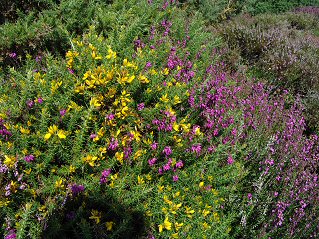
About one-tenth of the world’s resource of this glorious habitat lies within Exmoor National Park. It consists of a mixture mainly of Bell Heather (Erica cinerea), low growing Western Gorse (Ulex gallii), Ling (Calluna vulgaris) and Bristle Bent grass (Agrostis curtissii).
In late July and August, when the shrubs are in flower and the Bent has turned flaxen, there is a wonderful carpet of colour in areas such as North Hill, Minehead. Stonechats and Linnets are frequently seen, Common Lizards bask in the sun and Small Heath butterflies dance across the heath.
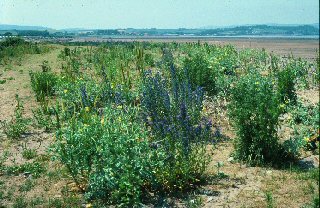
Dune flora at Dunster Beach
(a) Sand Dunes. There is such a wealth of dune flora to be found only at the eastern end of the National Park that Exmoor Natural History Society could not resist including Dunster Beach and Minehead Golf Links within their area of operation although technically they fall just outside of the designated National Park area.
Here, Fragrant Evening Primrose (Oenothera stricta), Viper’s Bugloss (Echium vulgare), Weld (Reseda lutea), Hound’s-tongue (Cynoglossum officinale), etc. mingle to make a colourful display in summer. Dune Thread-moss (Bryum dunense) has been recorded. The Golf Links support rarities including Sand Catchfly (Silene conica) and SlenderThistle (Carduus tenuiflorus). Several small clovers, vetches and early Forget-me-not may also be found. This is a good area for wading birds in the winter months also for passage migrants.
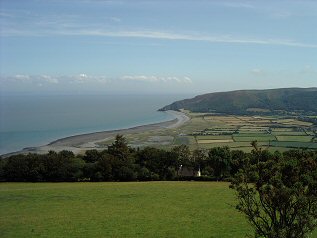
(b) Shingle and Saltmarsh. Porlock Beach and Weir are the areas for these. One of the world’s most perfect examples of a drift ridge was severely breached in 1996 resulting in flooding of the inland side with salt water which lay for several weeks. Since then the area floods regularly on high tide and it is changing from poor grazing land to salt-marsh.
The greatest loss is the former reedbed which provided nesting areas for birds including Sedge and Reed Warblers. Certain invertebrates, particularly moths have disappeared. It is to be hoped however that the saltmarsh area, when it settles down and the invertebrate content has increased, will become a feeding area for Redshank, Greenshank, Curlew, etc. It has always been an important area for bird watchers where many duck, geese, waders, passage migrants such as wheatear, and storm-blown birds may be seen. Yellow Horned-poppy (Glaucium flavum) and Narrow-leaved Everlasting Pea (Lathyrus sylvestris) grow on the shingle ridge and saltmarsh plants include, Sea Aster (Aster tripolium), Sea Spurrey (Spergularia spp.), Annual Sea-blite (Suaeda maritima), Glasswort (Salicorina europaea) and Sea Arrowgrass (Triglochin maritima). Migrating butterflies such as Clouded Yellow and Painted Lady also occur.
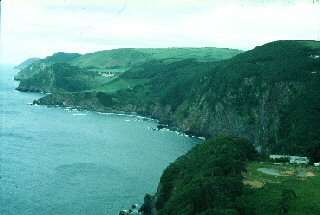
(d) Beaches. Our Society also records the seaweeds and creatures to be found on the accessible beaches along the coast of Exmoor. Sandy beaches provide various lug- and rag-worms industriously dug by fishermen as bait and wading birds as food.
(c ) Coastal cliffs. To appreciate these we suggest walking from Woody Bay to Hunters Inn, where the scenery on a fine day is unsurpassed. From this walk you may see nesting sea-birds such as Guillemot, Razorbill, Fulmar and various gulls. You may glimpse a passing gannet or grey seal out to sea.

There is a Saballeria reef off of Minehead which is built by worms which cement grains of sand together to make tubes in which to live. Periwinkles, Limpets, Sea Anemones, Crabs of many kinds are to be found and fish may be stranded in rock pools. The tide line may be littered with shells of dead sea creatures and ‘mermaid’s purses’ – the egg-cases of various fish regularly occur. A walk along a beach nearly always produces something of interest but a knowledge of the tides is essential as in some places it comes in very quickly and many people have been cut off necessitating rescue by lifeboat or helicopter.
WOODLANDS. These are either broadleaved or coniferous.

(a) Broadleaved Woodland. It is without doubt that with the combination of the Barle Valley Woodlands, the Horner Woods complex and the Lyn Valley Woodlands, Exmoor is blessed with some of the finest woodlands in the country.
Barle Valley are notable for Bluebells, Lichens and butterflies, Horner Woods for Lichens, Fungi and Bats and Lyn Valley has birds, Irish Spurge, rare ferns, Bryophytes and invertebrates in abundance. There are also runs of salmon and trout along the East Lyn River. There are many smaller mixed woodlands in which it is a delight to wander, particularly in spring. The ancient oak woodlands, many of which have been coppiced in the past to provide bark for tanning leather, are home to birds such as Nuthatch, Tree Creeper, Pied Flycatcher, Tawny Owl, tits, finches and thrushes, etc., etc. ENHS have nest boxes in Horner, Treborough, Woodcock Gardens. The main areas consist of Sessile Oak (Quercus petraea), but there are stands of other species such as Holm Oak (Q. ilex) at Selworthy and Allerford, Beech at Simonsbath, Birch in upland areas and occasionally, Holly. What Elm we had was lost to Dutch Elm disease apart from hedgerow shrubs.

(b) Conifer Plantations.Most, if not all conifers on Exmoor have been introduced. Some now self-seed. The main areas are on Croydon Hill, where felled areas are popular with the Nightjar and it may be heard churring on summer evenings.
The other main conifer plantations are on Periton Hill and the Brendon Hills. There are many other small stands of conifers. There are some very fine specimens of Douglas Fir at Broadwood near Dunster. Birds to look out for are Crossbills, which feed on the seeds of cones which they can extract with their curious beaks. Squirrels also like fir cones but they are culled by Forestry operators because of the damage they do to trees. Croydon Hill is also home to Fallow Deer and bats as well as Nightjars flit up and down the forest rides catching moths and other insects.
MOORLAND. Mainly falls into one of two types, heather or grass moorland.
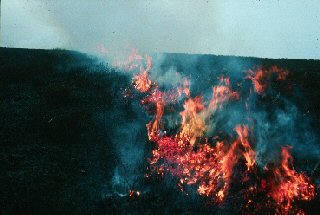
a) Heather Moorland. The third week in August is traditionally the best time to see the Ling (Calluna vulgaris) in flower. Dunkery Beacon and many acres on the Holnicote Estate owned by the National Trust is magnificent and perhaps one of the best areas.
Brendon Common is also good. The traditional management is swaling early in the year when areas are burned to create new growth but these days it has to be very carefully managed. Over burning or too frequent burning results in spread of bracken and this has encroached in many places. Another threat to heather is the Heather Beetle which damages the stalks causing them to die off. Correct burning should however help control this. The native Black Grouse once frequented the heather moors but the last to be recorded was on Molland Common in 1984 and it is now extinct on Exmoor. Red Grouse too have possibly died out, two or three were seen in 2003 but possibly they were introductions. The Ring Ouzel regularly bred on the moors until recently but in 2003 and 2004 only passage migrants were seen and apparently none stayed to nest. Whinchats, Cuckoos, Grasshopper Warbler, Tree Pipit, Meadow Pipit, Skylark, Wheatear are among the regularly seen birds and more rarely, Hen Harrier, Merlin, Short-eared Owl and Great Grey Shrike.

b) Grass Moorland. Areas of Molinia Grass, Cotton Grasses, Tussock Grass and Deergrass situated mainly within the old Forest of Exmoor Boundaries. Usually wet and soggy but has dried out in some places. A wild, bleak landscape with the occasional standing stone from which to get ones bearings in the days before GPS.
Snipe suddenly spring up in front of you and the lonely cry of curlew are typical of these areas. Lots of small frogs hop among the rushes and sedges and rushes abound in the damp areas. Dragonflies may be seen hunting for prey. Certainly the most challenging and wildest part of Exmoor . Stone walls provide nest sites for wheatears.

c) Reclaimed moorland.There are many acres of moorland where heather or molinia grass once grew which have been treated with nitrates in the past and converted to grazing land for stock. With less grazing, rushes now grow in many of these areas.

d) Bogs and Mires. Botanically, the most interesting moorland flowers are found in the wet areas where Sphagnum mosses grow in the springs and valley bottoms.
Lesser Skullcap, Bog Pimpernel, Bog Asphodel, Ivy-leaved Bellflower, Cranberry, Moorland Crowfoot, Bog Pondweed and the insectivorous Sundew, Pale Butterwort and Greater Butterwort are but a few. Marsh Fritillary butterflies may be found where their food-plant Devil’s-bit Scabious grows.
Note: Areas of dry moorland which do not fit into any of the above categories would probably be classed as Heaths. Typically these support Gorse (Ulex europaea), Hawthorn (Crataegus monogyna) Bracken (Pteridium aquilinum), patchy heather and scrub. They are ideal nesting sites for Stonechats, Linnets, Meadow Pipits. Tormentil, Heath Milkwort, Heath Spotted Orchid are common plants.
WATER. This habitat varies according to type.
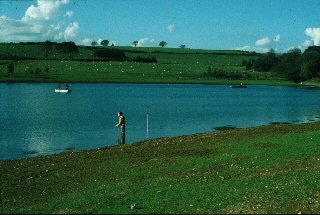
a) Reservoirs and ponds. There are Reservoirs at Wimbleball, Nutscale and Challacombe. (Clatworthy is outside our area as is most of Wistlandpond). There are manmade ponds at Pinkworthy and many smaller ponds on farms, etc.
The Reservoirs are stocked with fish which provide hours of entertainment for fishermen. Wimbleball Lake is a winter haunt of bird watchers with regular sightings of duck, geese, coot, grebe etc. and the occasional rarity such as the long-tailed duck in 2003. Large flocks of Canada Geese occur. At Pinkworthy there are rare plants such as Least Bur-reed (Sparganium natans) and this is also a very good area for dragonflies. The Hawn Pool at Dunster Beach is also a very interesting area. Other standing water is found in ditches and brackish water on coastal marshes. Cattle troughs and even puddles on paths all have their attendant wildlife ranging from freshwater algae to tadpoles, frogs, toads and palmate newts.
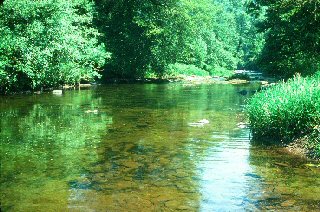
b) Rivers and Streams.Riverside plants include Yellow Iris (Iris pseudacorus), Water Forgetmenot (Myosotus aquatica), Monkey-Musk (Mimulus) and various Mints. The dipper is a favourite bird on the streams, usually with Grey Wagtails in the vicinity.
The larger rivers, the Exe and the Barle have the occasional kingfisher and some breeding Sandmartins. Fly-fishing for wild brown trout and salmon is excellent. There are many miles of smaller streams and tributaries. In recent years the otter has made a come back but despite the best efforts of the Environment Agency to create otter tunnels under roads a number are run over each year.
ROCK
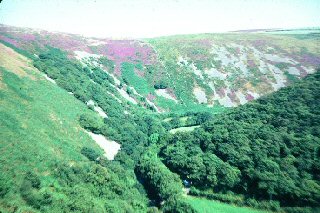
As well as sea cliffs there are inland quarries which provide nesting places for birds including kestrel and jackdaws. Plants such as stonecrop and many ferns grow on stone walls and there are also areas of scree and old spoil heaps gradually being colonised by various lichens and mosses. The unique Valley of Rocks near Lynton is home to a flock of semi wild goats.
HEDGEROWS
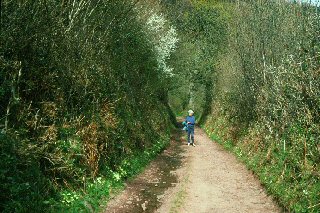
Hedgerows, hedgebanks and verges of lanes and tracks leading from place to place make journeys of great interest to the naturalist.
Primroses, Cow Parsley, Red Campion, Lesser Celandine, Hazel, Dog Roses, Stitchwort, Wild Strawberry and Brambles add colour and provide food for passing humans, birds and mammals such as dormice and field mice. Good hedges are essential for nesting birds, they form corridors for dormice, and habitat for butterflies such as the Orange Tip. Beech hedges, which retain their leaves even when dead, provide shelter for sheep and are a feature of upland farms
FARMS AND VILLAGES
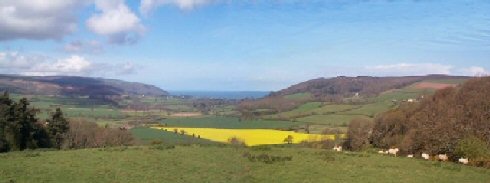
a) Farmland. Remember that farmland is not generally open to the public and that grass is a crop to feed animals not to be walked over regardlessly. With suitable permission, there is much to see on farmland but even without special permission there are many footpaths which traverse fields from which it is quite possible to see corn stubble weeds such as poppies, wild pansy, field woundwort, etc. Damp meadows support cuckoo flowers and meadow buttercups. Gateways are particularly good hunting grounds. Finches, Yellowhammers, Spotted Flycatchers and House Martins frequent farm buildings. Rabbits are much fewer than formerly but there are plenty around and Mr Tod the Fox has an eye on them. Old unimproved grassland often has anthills. Farming on the uplands, traditionally sheep on Exmoor, is very different from lowland arable farming.
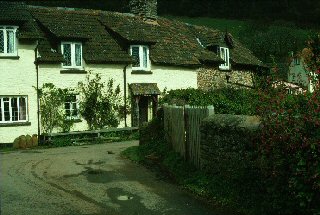
b) Villages. Old walls and churchyards are particularly good places to look for ferns, lichens, mosses and liverworts as well as the many flowers.
Many plants formerly grown for herbal use have escaped and are now naturalised round villages such as Feverfew, Greater Celandine, Evergreen Alkanet, Tansy. Slow-worms are fond of gardens and allotments, particularly if there is a piece of carpet or galvanised metal for them to lie under. Garden birds are familiar to all but no doubt food put out during winter months by householders is essential to Robins, Blackbirds, Blue Tits, Thrushes and the like.